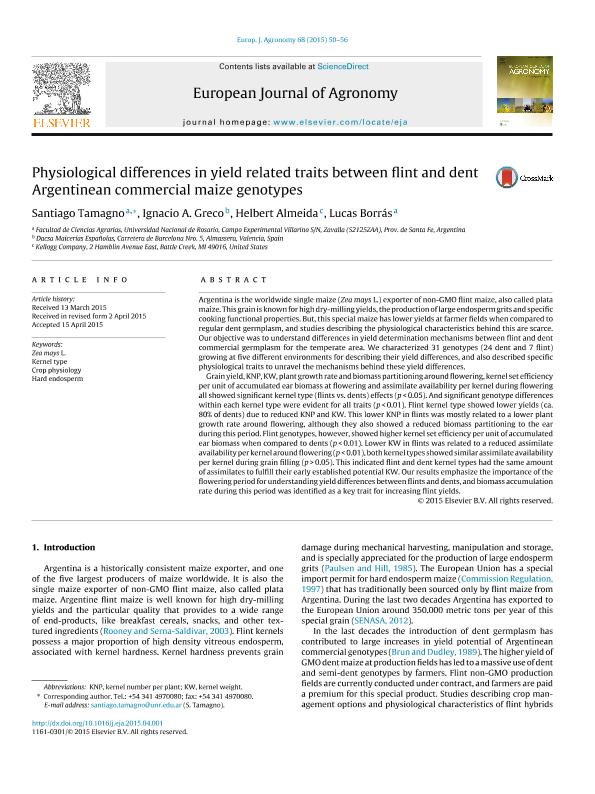Mostrar el registro sencillo del ítem
dc.contributor.author
Tamagno, Santiago
dc.contributor.author
Greco, Ignacio A.
dc.contributor.author
Almeida, Helbert
dc.contributor.author
Borras, Lucas

dc.date.available
2017-02-23T20:47:04Z
dc.date.issued
2015-08
dc.identifier.citation
Tamagno, Santiago; Greco, Ignacio A.; Almeida, Helbert; Borras, Lucas; Physiological differences in yield related traits between flint and dent Argentinean commercial maize genotypes; Elsevier Science; European Journal Of Agronomy; 68; 8-2015; 50-56
dc.identifier.issn
1161-0301
dc.identifier.uri
http://hdl.handle.net/11336/13336
dc.description.abstract
Argentina is the worldwide single maize (Zea mays L.) exporter of non-GMO flint maize, also called plata maize. This grain is known for high dry-milling yields, the production of large endosperm grits and specific cooking functional properties. But, this special maize has lower yields at farmer fields when compared to regular dent germplasm, and studies describing the physiological characteristics behind this are scarce. Our objective was to understand differences in yield determination mechanisms between flint and dent commercial germplasm for the temperate area. We characterized 31 genotypes (24 dent and 7 flint) growing at five different environments for describing their yield differences, and also described specific physiological traits to unravel the mechanisms behind these yield differences.
Grain yield, KNP, KW, plant growth rate and biomass partitioning around flowering, kernel set efficiency per unit of accumulated ear biomass at flowering and assimilate availability per kernel during flowering all showed significant kernel type (flints vs. dents) effects (p < 0.05). And significant genotype differences within each kernel type were evident for all traits (p < 0.01). Flint kernel type showed lower yields (ca. 80% of dents) due to reduced KNP and KW. This lower KNP in flints was mostly related to a lower plant growth rate around flowering, although they also showed a reduced biomass partitioning to the ear during this period. Flint genotypes, however, showed higher kernel set efficiency per unit of accumulated ear biomass when compared to dents (p < 0.01). Lower KW in flints was related to a reduced assimilate availability per kernel around flowering (p < 0.01), both kernel types showed similar assimilate availability per kernel during grain filling (p > 0.05). This indicated flint and dent kernel types had the same amount of assimilates to fulfill their early established potential KW. Our results emphasize the importance of the flowering period for understanding yield differences between flints and dents, and biomass accumulation rate during this period was identified as a key trait for increasing flint yields.
dc.format
application/pdf
dc.language.iso
eng
dc.publisher
Elsevier Science

dc.rights
info:eu-repo/semantics/openAccess
dc.rights.uri
https://creativecommons.org/licenses/by-nc-sa/2.5/ar/
dc.subject
Knp
dc.subject
Kernel Number Per Plant
dc.subject
Kw
dc.subject
Kernel Weight
dc.subject.classification
Agricultura

dc.subject.classification
Agricultura, Silvicultura y Pesca

dc.subject.classification
CIENCIAS AGRÍCOLAS

dc.title
Physiological differences in yield related traits between flint and dent Argentinean commercial maize genotypes
dc.type
info:eu-repo/semantics/article
dc.type
info:ar-repo/semantics/artículo
dc.type
info:eu-repo/semantics/publishedVersion
dc.date.updated
2017-02-23T13:54:08Z
dc.journal.volume
68
dc.journal.pagination
50-56
dc.journal.pais
Países Bajos

dc.journal.ciudad
Amsterdam
dc.description.fil
Fil: Tamagno, Santiago. Universidad Nacional de Rosario. Facultad de Ciencias Agrarias; Argentina
dc.description.fil
Fil: Greco, Ignacio A.. Dacsa Maicerías Españolas; España
dc.description.fil
Fil: Almeida, Helbert. Kellogg Company; Estados Unidos
dc.description.fil
Fil: Borras, Lucas. Universidad Nacional de Rosario. Facultad de Ciencias Agrarias; Argentina. Consejo Nacional de Investigaciones Científicas y Técnicas. Centro Cientifico Tecnológico Rosario; Argentina
dc.journal.title
European Journal Of Agronomy

dc.relation.alternativeid
info:eu-repo/semantics/altIdentifier/doi/http://dx.doi.org/10.1016/j.eja.2015.04.001
dc.relation.alternativeid
info:eu-repo/semantics/altIdentifier/url/http://www.sciencedirect.com/science/article/pii/S1161030115000428
Archivos asociados
